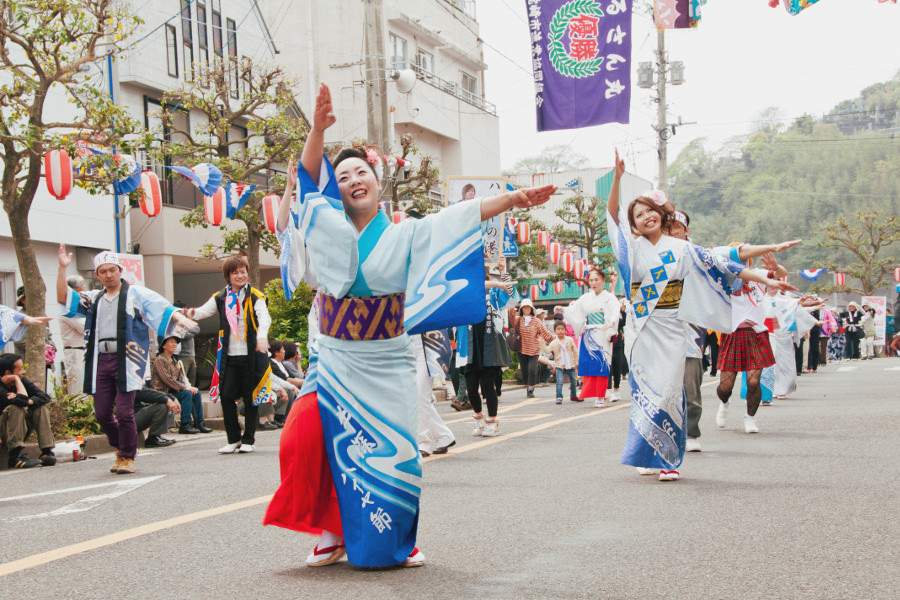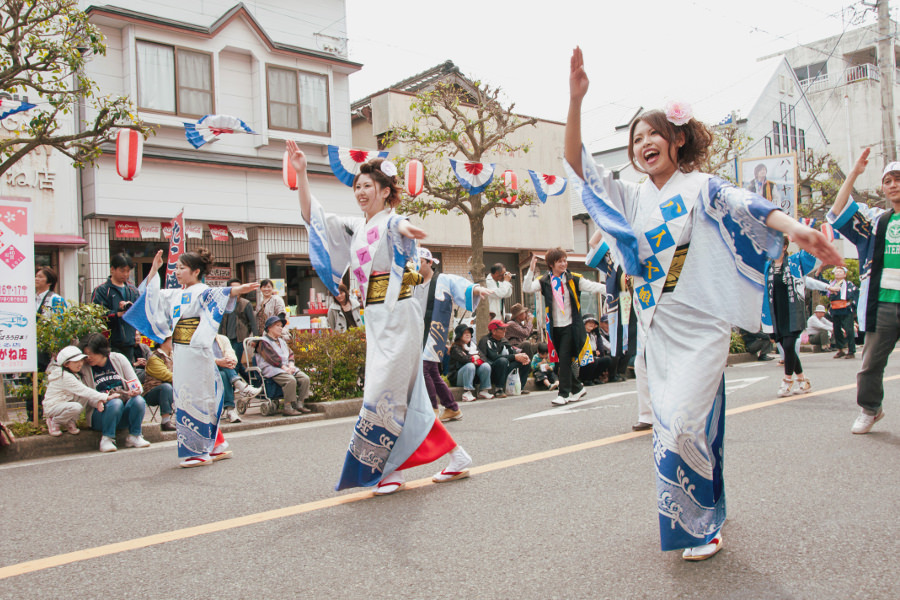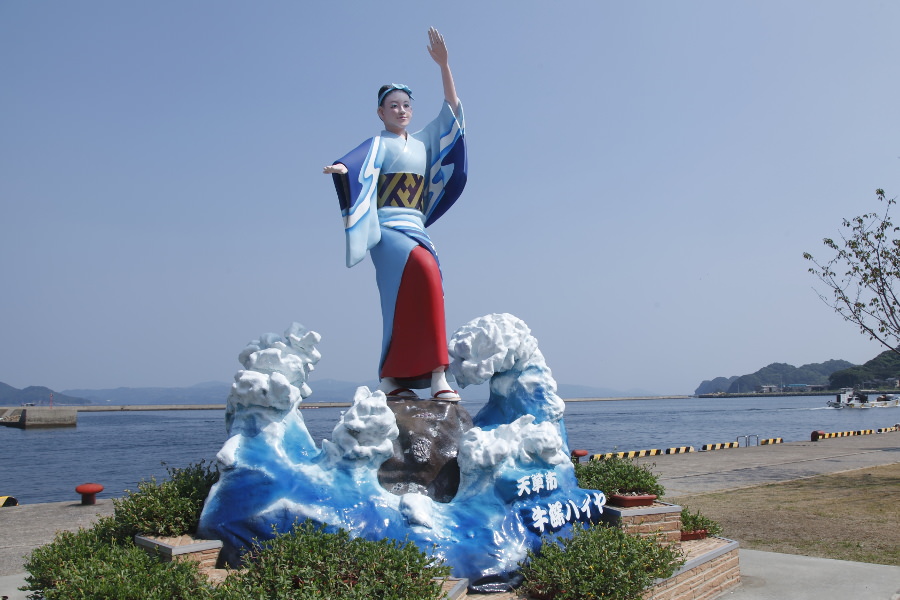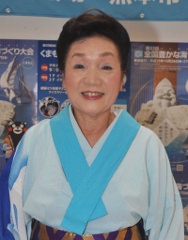News お知らせ
- The 49th Ushibuka Haiya Festival, specially held as “Defeat Corona! Haiya’s Competition”.
- Ushibuka Summer Haiya Festival
Summer Haiya Festival:
Celebrating Ushibuka’s Signature Folk Song
Few things are more reminiscent of a Japanese summer than the matsuri. Hate the sweltering daytime heat if you must, but summer festivals remain one of the most magical parts of summer. Who could fail to feel a rush of joy at donning a yukata (summer kimono) on a sultry evening, or excitement at hearing drums in the distance, the trilling, plaintive melodies of the bamboo flute and twanging shamisen soaring above the sounds of singing and laughter? It is a time for community and merriment, and above all is a way of keeping the traditional folk songs of Japan alive.
”Ushibuka Haiyabushi”
the roots of Haiya folk songs
ハイヤ系民謡のルーツとも言われる「牛深ハイヤ節」
“Ushibuka Haiyabushi” is a folk song born in Ushibuka in the latter half of the Edo period. It is said that “Ushibuka Haiyabushi” was spread all over the country by sailors at Ushibuka Port.
If you want to fully enjoy “Ushibuka Haiya Odori”, a dance that has been added to the Ushibuka Haiyabushi, you should visit the “Ushibuka Haiya Festival” after all.
牛深ハイヤ節は、江戸時代後期に、牛深で生まれた民謡です。当時、牛深港に集まっていた船乗り達によって全国に広まったと言われています。
そして、牛深ハイヤ節に踊りを組み合わせたのが、牛深ハイヤ踊りです。この踊りを満喫するには、牛深ハイヤ祭りを訪れるのが一番です。
“Ushibuka Haiya Festival” held every April
毎年4月に開催される牛深ハイヤ祭り

The folk song “Ushibuka Haiyabushi”, which has been handed down to Ushibuka-cho in Amakusa City since the late Edo period, features rhythms peculiar to the southern country and peculiar moderation. Ushibuka, which has a calm natural harbor, was once a transit base for many seafarers.
It is said that the beginning of “Ushibuka Haiyabushi” is that local women sang to entertain such sailors. Ushibuka Haiya Odori is a dance of Haiyabushi. At the Ushibuka Haiya Festival, held every April, dances are performed Haiya Festival. Above all, “So-odori(Grand Haiya Dance)”, full of dynamism, is a highlight.
江戸時代後期から天草市牛深町に受け継がれている民謡である牛深ハイヤ節は、南国特有のリズムと独特の節回しが特徴の民謡です。穏やかな天然の良港を有する牛深は、かつて国内外の航路の中継基地として、船の往来が盛んで、多くの船乗りに重宝されてきました。
そんな船乗りたちを、おもてなしするために地元の女性たちが唄ったことが、牛深ハイヤ節の起源といわれています。そして、このハイヤ節に踊りを加えたものが「牛深ハイヤ踊り」です。毎年4月に開催される「牛深ハイヤ祭り」では、軽快なハイヤ節にのせて踊りが披露されます。中でも躍動感あふれる「総踊り」は圧巻で、大変人気です。
Let’s go to the Ushibuka Haiya Festival,
a spring traditional events in Amakusa
天草の春の風物詩「牛深ハイヤ祭り」へ・・・
Ushibuka Haiya Festival, where young and old men and women dance
老若男女が踊りを楽しむ牛深ハイヤ祭り

The Ushibuka Haiya Festival began in 1972 in order to inherit the “Ushibuka Haiya Odori”, a dance that was added to Ushibuka Haiya Bushi, which has been sung in Ushibuka as a traditional performing art. The current Ushibuka Haiya Festival is held every April for three days, the third Friday, Saturday and Sunday, and attracts a large number of tourists visiting from outside the city.
伝統芸能として牛深で唄い継がれてきた民謡「牛深ハイヤ節」に踊りを加えた「牛深ハイヤ踊り」を継承していくために、1972年から始まったのが「牛深ハイヤ祭り」です。現在の「牛深ハイヤ祭り」は、毎年4月の第3金・土・日曜の3日間にわたって開催され、市内外から訪れる大勢の観光客でにぎわいます。
One of the highlights of the Ushibuka Haiya Festival is the “So-odori(Grand Haiya Dance)”, which is held twice at 19:00 on Saturday and at 13:00 on Sunday. Thousands of young and old men and women dressed in Happi parade around the town with shamisen and drum music.
牛深ハイヤ祭りの一番の見どころは、2日目の土曜日19時からと、3日目の日曜日13時からの2回行われる「ハイヤ総踊り」です。法被に身を包んだ数千人の老若男女が、三味線や太鼓の囃子とともに町を練り歩きます。
A dynamic dance is performed with the shouting “Yoisar, Yoiser” on the light rhythm of the Haiya clause, and the whole town of Ushibuka is wrapped in heat. The atmosphere of the festival is completely different between Saturday at night and Sunday at noon. If possible, stay in the local area and enjoy two different expressions.
軽快なハイヤ節のリズムにのせて、“ヨイサー、ヨイサー”という掛け声とともにダイナミックな踊りが披露され、牛深の町全体が熱気に包まれます。夜に行われる土曜の総踊りと、昼に行われる日曜の総踊りでは、祭りの雰囲気は全く異なります。牛深に宿まり、二つの異なる総踊りの魅力を感じてください。
Jump in and participate “Ushibuka Haiya So-odori(Grand Haiya Dance)”.
Also you can enjoy Markets and marine parades
ハイヤ総踊りは、予約無しで参加もできます。また、物産販売や会場パレードも楽しめます。
Fishing fleet marine parade ” where dozens of fishing boats run on the sea
数十隻の漁船が海上を疾走する「漁船団海上パレード」

On both days, “So-odori(Grand Haiya Dance)” has a group called “tobiiri-maru ” for general participants, and tourists can jump in. Immediately before the start of the total dance, a course is held by Ushibuka Haiya Preservation Society, so you can participate without worrying about choreography. If you visit the area with great effort, feel the heat of the festival with your whole body.
ハイヤ総踊りでは、土日ともに、「飛び入り丸」という一般参加者向けの団体が用意されており、観光客の飛び入り参加が可能です。総踊りの開始直前には、牛深ハイヤ保存会による講習会も行われますので、振り付けを知らない方でも安心して参加できます。せっかく現地を訪れた機会に、祭りの熱気を五感で感じてください。
In addition to Ushibuka Haiya Festival, there are various events besides “So-odori(Grand Haiya Dance)”. “Ushibuka’s famous Haiya markets”, which is held on Saturday and Sunday, offers a variety of marine products, as well as dishes using fresh Ushibuka seafood.
牛深ハイヤ祭りでは総踊りのほかにも、さまざまな催しが行われます。土日の2日間、開催される「牛深名産ハイヤ市」では、牛深の新鮮な魚介を使った料理のほか、多彩な海産物が販売されます。
The “Fish Fleet Marine Parade” is held around Ushibuka Port on Sunday. Don’t miss a parade where dozens of fishing boats carrying bright big fishing flags splash and splash on the sea.
日曜には、牛深港周辺で「漁船団海上パレード」が行われます。鮮やかな大漁旗を掲げた数十隻の漁船が、水しぶきをあげながら海上を疾走するパレードも必見です。
A port town that has long prospered as a key point in maritime traffic — Ushibuka
古くから海上交通の要衝として栄えた港町 ―― 牛深
“Ushibuka Haiya Bridge”, one of the scenery representative of Ushibuka
牛深を代表する景観の一つ、「牛深ハイヤ大橋」

Located in the southwestern part of Kumamoto Prefecture, Amakusa consists of 120 islands, large and small, centered on Kamishima and Shimoshima. Surrounded by three seas, the Ariake Sea, Yatsushiro Sea (Shiranui Sea) and the East China Sea, the scenic scenery spreads.
天草は、熊本県の南西部にあり、上島(かみしま)・下島(しもしま)を中心に、大小120の島々から構成される島々です。周囲を有明海、八代海(不知火海)、東シナ海と三つの海に囲まれ、風光明媚な景観が広がっています。
Ushibuka-cho, Amakusa City, located at the southernmost tip of Amakusa, is a port town with Ushibuka Fishing Port, the prefecture’s largest fishing base. Ushibuka Fishing Port, which has a deep cove, was once a calm and natural good port without anchoring, so it has long prospered as a rich seafood production center and a key point of maritime transportation.
天草の最南端に位置する天草市牛深町は、県内最大の漁業基地である牛深漁港を有する港町です。深い入江を持つ牛深漁港は、かつては碇いらずの穏やかな天然の良港であったため、古くから豊かな海産物の産地として、また海上交通の要衝として栄えてきました
The “Ushibuka Kaisaikan” is one of the museums where you can study the history of fisheries. In the museum you can see the replica “The kingdom of JAPAN” which was written by the Spanish, Avila Giron, during the voyage of the 15th and 16th centuries. He introduced Ushibuka as a good port for any kind of boat.
牛深の漁業の歴史に触れられるのが、観光施設「うしぶか海彩館」内にある「漁業史資料館」だ。15~16世紀の大航海時代にスペイン人のアビラ・ヒロンによって書かれたという『日本王国記』にも、「牛深のそれ(港)はどういう船にも向く良港である」と紹介されている。
The birthplace of Haiya songs nationwide
全国で唄い継がれるハイヤ節の“発祥の地”
Haiya Musume’s monument welcomes you at Ushibuka Port Ferry Terminal
牛深港フェリー発着場では、ハイヤ娘のモニュメントがお出迎えします。

In Ushibuka-cho, Amakusa-shi, Ushibuka Haiya-bushi, the roots of Haiya folk songs nationwide, was born in the late Edo period. At that time, Ushibuka, an important base for maritime traffic, had many sailing ships carrying marine products.
天草市牛深町で、全国のハイヤ系民謡のルーツといわれる牛深ハイヤ節が誕生したのは、江戸時代後期のことです。当時、海上交通の重要な拠点であった牛深には、海産物などを運搬する帆船が多く出入りしていました。
It is said that the beginning of Ushibuka Haiya-bushi was sung by a Ushibuka woman at a banquet in order to entertain the sailors who stopped at Ushibuka Port for waiting for passing the storm, waiting for the wind, buying and selling cargo, and so on. Sailors spread the Haiya-bushi to ports around the country, and with various arrangements, became established.
時化待ちや風待ち、積荷の売買などで牛深港に寄港した船乗りたちをもてなすために、酒宴の席で牛深の女性が唄ったものが、牛深ハイヤ節の始まりといわれています。船乗りたちによって、このハイヤ節が全国各地の港へと広められ、さまざまなアレンジが加わって各地に定着していったのです。
It is said that folk songs whose roots are Ushibuka Haiya are thus sung in about 40 places. Among them, “Sado Okesa” in Niigata Prefecture and “Awa Odori” in Tokushima Prefecture are well known.
牛深ハイヤ節をルーツとする民謡は、こうして約40カ所に唄い継がれているといいます。中でも、新潟県の「佐渡おけさ」や徳島県の「阿波踊り」などがよく知られています。
The origin of Haiya is “HAE (southern wind)”, which is an essential wind for sailing ships sailing north from Ushibuka. It is believed that the HAE became a HAEYA and then aHAIYA.
In Haiya-bushi you can hear these lyrics “Did the ship that left this morning due to the wind from south reached safely to the next harbor? In this lyrics the thoughts of Ushibuka’s women are included.
ハイヤの語源は「ハエ(南風)」で、牛深を出港して北上する帆船に欠かせない風のことです。このハエがハエヤになり、さらにハイヤに変化していったと考えられています。「ハイヤで今朝出た船はエー どこの港にサーマ入れたやらエー(ハエの風で今朝出港した船は、どこの港まで行き着いただろうか)」という唄い出しには、船乗りの身を案じる牛深の女性たちの思いが込められているのです。
A stone monument of “The origin of Hayabushi” is erected on the Ushibuka Haiya Bridge from the side of “Ushibuka Kaisaikan”.
「うしぶか海彩館」側から牛深ハイヤ大橋を渡りきった場所には、「ハイヤ節発祥之地」の石碑が建立されている。
Junko Hayamizu 早水 純子
Master of Ushibuka Haiya 牛深ハイヤの達人 牛深ハイヤ保存会「早水社中」代表

Born in Ushibuka-cho, Amakusa City. Representative of Ushibuka Haiya Preservation Society “Hayamizushachu” formed in 1980. He has been supporting Haiyah for more than half a century through appearances in events around the country and the development of successors. She is still active while Over 80 years old,and is committed to the succession and promotion of Haiya culture. The stage name of the dance (Natori) is “Kojyun Fujima”.
天草市牛深町出身。1980年に結成された牛深ハイヤ保存会「早水社中」代表。全国各地でのイベント出演や後継者の育成などを通して、半世紀以上にわたってハイヤを支えてきた功労者。傘寿を迎えた後もなお現役で、ハイヤ文化の継承やPRに尽力されている。
